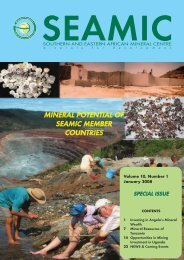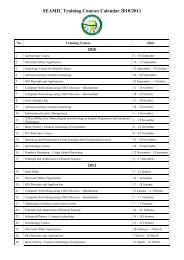SOUTHERN AND EASTERN AFRICAN MINERAL CENTRE - SEAMIC
SOUTHERN AND EASTERN AFRICAN MINERAL CENTRE - SEAMIC
SOUTHERN AND EASTERN AFRICAN MINERAL CENTRE - SEAMIC
Create successful ePaper yourself
Turn your PDF publications into a flip-book with our unique Google optimized e-Paper software.
Kavirondian, is only slightly younger than Nyanzian but folding in the two systems has<br />
similar orientation. Numerous granitic bosses and batholiths have intruded the Nyanzian<br />
and Kavirondian. The Kavirondian intrusions were more but the pre-Kavirondian were<br />
also widespread and the two systems are discernible.<br />
2. Mozambique Belt<br />
The Mozambique belt is a structural unit within which a wide variety of meta-sedimentary<br />
and meta-igneous rocks are found showing a broad concordance of structural style and<br />
metamorphic history. In most of these rocks, the degree of deformation is intense and is<br />
of high metamorphic grades. They were thus referred to earlier in literature as the basement<br />
system rocks, due to high degree of metamorphism and deformation.<br />
Recent work on the Mozambique Belt has shown that rocks can be sub-divided into<br />
groups of contrasting lithology, structure and composition of igneous rocks content. These<br />
groups are being studied in greater detail in order to come up with proper chronostratigraphic<br />
terminology.<br />
Within the Mozambique Belt basic igneous complexes are found and range in size from<br />
bosses to small dykes. They occur both east and west of the Rift Valley. Some of the older<br />
basic intrusions have undergone deformation and metamorphism to give ortho-amphibolites<br />
and charnockitic gneisses.<br />
Basic and granitic intrusions are known in the Mozambique Belt. The most characteristic<br />
feature of the Mozambique Belt is its structural trend which is more or less north-south in<br />
its entire belt.<br />
Variations of the northerly trend are minor and, when observed, can be explained and are<br />
localised. The majority of Mozambique Belt rocks have been placed in upper Precambrian<br />
(Proterozoic).<br />
3. Palaeozoic and Mesozoic Formations<br />
Palaeozoic and Mesozoic formations in Kenya are found near the coast and in north-eastern<br />
Kenya. The earliest of these rocks are Permo-Carboniferous which are mostly sandstones<br />
and shales that form the Duruma series. This is equivalent to the Karroo system in<br />
Southern Africa. The local formations are Taru; Maji-ya-Chumvi; Mariakani and the<br />
Mazeras. They extend for about 100 kilometres from Taru to Mazeras, west of Mombasa.<br />
The rocks dip very gently towards the ocean and are heavily faulted in places.<br />
Mesozoic rocks occur in two separate areas, in the north-east part of Kenya and along the<br />
Coast belt. The stratigraphy and fossils in the two areas are very distinct and it is likely<br />
that the sedimentary basins in the two areas were connected. Revision mapping in the area<br />
has come up with interesting lithological units that have revised lithological names.<br />
4. Tertiary and Quaternary Volcanics<br />
Volcanic rocks cover the central parts of the country from south to north, occurring in the<br />
floor of the Rift Valley and on the peneplains west and east of the valley.<br />
The oldest of the volcanics are of Lower Miocene age and comprise the eroded lavas and<br />
pyroclastic piles of South Nyanza. Late in Miocene times, Kapiti and Yatta phonolites<br />
were erupted and flowed to great lengths.<br />
6




